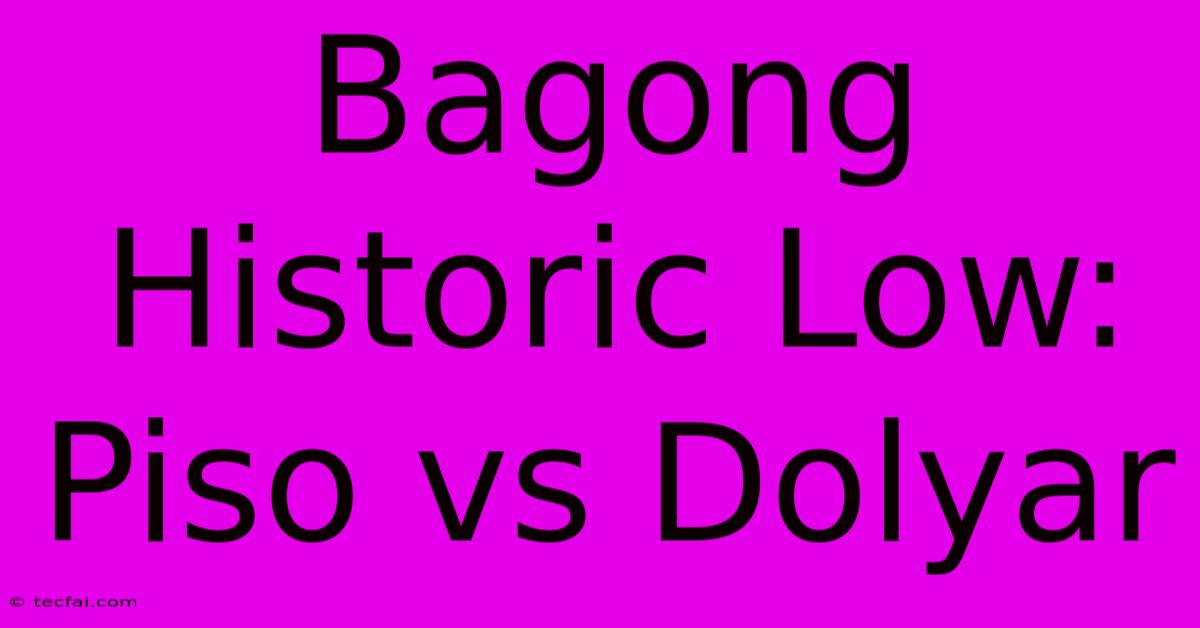Bagong Historic Low: Piso Vs Dolyar

Discover more detailed and exciting information on our website. Click the link below to start your adventure: Visit Best Website tecfai.com. Don't miss out!
Table of Contents
Bagong Historic Low: Piso vs Dollar – Understanding the Impact of a Weakening Philippine Peso
The Philippine peso's recent plunge to a historic low against the US dollar has sent ripples throughout the Philippine economy, sparking concern among businesses, consumers, and policymakers alike. This unprecedented weakening raises crucial questions about its causes, consequences, and potential solutions. Let's delve into the details of this significant economic event.
What Led to the Peso's Historic Low?
Several interconnected factors contributed to the peso's dramatic decline:
-
Global Economic Headwinds: The strengthening US dollar globally, driven by aggressive interest rate hikes by the Federal Reserve to combat inflation, is a primary culprit. A stronger dollar makes imports more expensive and puts downward pressure on emerging market currencies like the peso.
-
Inflationary Pressures in the Philippines: High inflation within the Philippines reduces the purchasing power of the peso, making it less attractive compared to more stable currencies. Rising import costs further exacerbate this problem, creating a vicious cycle.
-
Current Account Deficit: A significant current account deficit, reflecting a greater outflow of money from the Philippines than inflow, weakens the peso's demand. This imbalance indicates the country is importing more goods and services than it is exporting.
-
Geopolitical Uncertainty: Global uncertainty, including the ongoing war in Ukraine and its impact on energy prices and supply chains, contributes to investor anxiety and a flight to safety, boosting the dollar's appeal.
-
Interest Rate Differentials: The difference in interest rates between the Philippines and the US also plays a role. Higher interest rates in the US attract foreign investment, increasing demand for the dollar and further diminishing the peso's value.
The Impact of a Weakening Peso
The consequences of a weaker peso are far-reaching and affect various sectors:
-
Higher Import Costs: Imports become more expensive, impacting the prices of essential goods like fuel, food, and raw materials. This can lead to higher inflation and a reduced standard of living for many Filipinos.
-
Increased Debt Burden: The peso's depreciation increases the cost of servicing foreign-denominated debts for both the government and private businesses. This can strain public finances and hinder economic growth.
-
Reduced Purchasing Power: Filipinos find their purchasing power diminished as imported goods become pricier. This especially impacts low-income households who spend a larger portion of their income on essential goods.
-
Impact on Remittances: While overseas Filipino workers (OFWs) send remittances in dollars, the weaker peso means they send less in Philippine pesos, potentially affecting household incomes.
-
Tourism: While a weaker peso can attract more tourists due to lower costs for foreign visitors, the increased cost of imported goods for the tourism sector can offset any positive impact.
Potential Solutions and Mitigation Strategies
Addressing the peso's decline requires a multi-pronged approach:
-
Monetary Policy Adjustments: The Bangko Sentral ng Pilipinas (BSP) can adjust interest rates to attract foreign investment and stabilize the peso. However, this needs to be carefully balanced to avoid stifling economic growth.
-
Fiscal Discipline: The government needs to implement prudent fiscal policies to control inflation and reduce the current account deficit. This involves managing government spending effectively and promoting exports.
-
Investment in Export Industries: Boosting export-oriented industries can help increase foreign currency inflows and reduce reliance on imports. This requires investments in infrastructure, technology, and skills development.
-
Diversification of Trade Partners: Reducing dependence on a few major trading partners can help mitigate the impact of external shocks.
-
Strengthening Economic Fundamentals: Overall, improving the country's economic fundamentals, including infrastructure, education, and governance, is crucial for long-term stability and attracting foreign investment.
The peso's historic low is a serious challenge requiring a comprehensive and coordinated response. While short-term measures can help stabilize the situation, long-term solutions focus on strengthening the Philippine economy's resilience and competitiveness are essential for lasting stability. The government, the central bank, and the private sector must work together to navigate this economic headwind and ensure a more stable and prosperous future for the Philippines.

Thank you for visiting our website wich cover about Bagong Historic Low: Piso Vs Dolyar. We hope the information provided has been useful to you. Feel free to contact us if you have any questions or need further assistance. See you next time and dont miss to bookmark.
Featured Posts
-
Afl 2024 Rookie Draft Order Announced
Nov 22, 2024
-
British Tourist Death Methanol Case
Nov 22, 2024
-
Wise Tech Review Clears Founder
Nov 22, 2024
-
Watch India Vs Australia Test Series Live
Nov 22, 2024
-
Cleveland State Game Womens Basketball Cancelled
Nov 22, 2024
